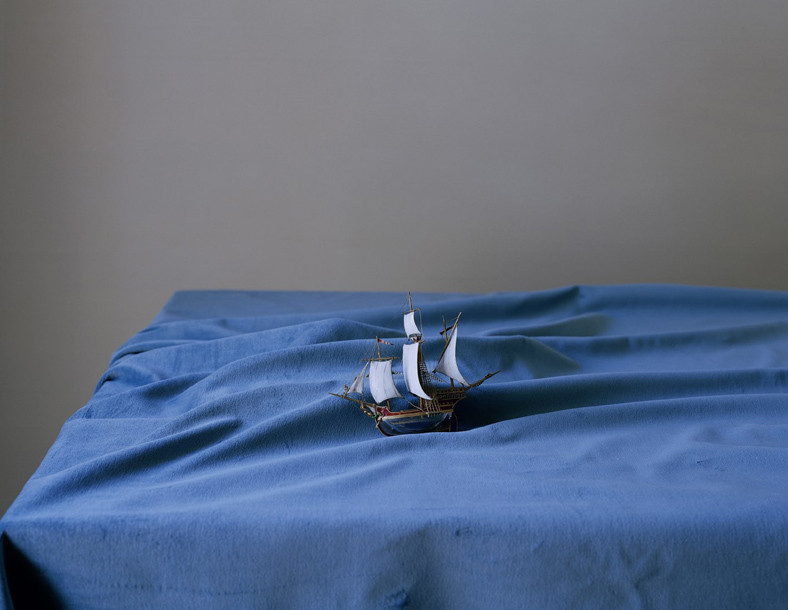Olivier Richon
16 Jan - 23 Feb 2013
OLIVIER RICHON
Acedia
16 January – 23 February 2013
Ibid is pleased to present its third solo show with Swiss photographer Olivier Richon entitled, Acedia.
The photographs in the exhibition are meant to trigger associations of thought. They provide a kind of map for idleness, boredom and reverie. Among the images, the wall texts on each of the three floors add another set of references. They propose mental images. The texts are quotes just as the photographs are also a form of quotation. Texts and images are best apprehended by an idle gaze.
On the ground floor loosely themed around the notion of a hunt, are images of a grey horse, riding boots, a dead deer, reminiscent of Gustave Courbet famous paintings of this animal, and a red blood-like fruit. A quotation from The Legend of Saint Julian the Hospitalier (1877), by Gustave Flaubert anchors the ritual of the hunt alluded to in the images.
The first floor of Acedia – the title describing a state of listlessness or idleness originally noted as a problem among monks and hermits – includes images of a dog with a ladder, a scull placed on a book, a broken egg, and two severed salmon heads. Some of these elements are adapted from the emblematic iconography of Dürer and Bosch. A text describes an excessive meal consumed by a Sadean character, and another, from Flaubert’s Temptation of Saint Antony (1874), tells us about the hermit’s hallucinations.
The second floor comprises images of relics taken in the restoration room of the Museo Lazaro Galdiano in Madrid: crystal glasses, a book, a miniature ship, an ivory gun powder horn, as well as busts serving as reliquaries. The pictures are accompanied by a quotation from Marivaux’sIn Praise of Nothing (1737) that does as the title explains, praise and condemn the inaction or objects that in their idleness can still cause disaster.
Richon has stated that he is concerned with the manner in which photography uniquely preserves the stillness of an object. He writes "The work proposes a reflection upon the animate and the inanimate, and the way in which a tension between the two is created". For example, tension is created between the controlled environment of the studio and the unpredictable behavior of the live animal as well as that of objects in front of the camera lens.
Olivier Richon was born in Lausanne in 1956. He studied at the Polytechnic of Central London and graduated with a BA (Hons) in Film and Photographic Arts in 1980 and a Masters of Philosophy in 1988.
His work has been exhibited internationally since 1980 including the Victoria and Albert Museum, London; the Musee de'art moderne de la ville de Paris; Museum Folkwang, Essen; the National Museum of Modern Art, Kyoto; the Brooklyn Museum, New York; The National Gallery of New South Wales, Australia; and Tate Britain, London. He is currently professor of Photography at the Royal College of Art, London.
Acedia
16 January – 23 February 2013
Ibid is pleased to present its third solo show with Swiss photographer Olivier Richon entitled, Acedia.
The photographs in the exhibition are meant to trigger associations of thought. They provide a kind of map for idleness, boredom and reverie. Among the images, the wall texts on each of the three floors add another set of references. They propose mental images. The texts are quotes just as the photographs are also a form of quotation. Texts and images are best apprehended by an idle gaze.
On the ground floor loosely themed around the notion of a hunt, are images of a grey horse, riding boots, a dead deer, reminiscent of Gustave Courbet famous paintings of this animal, and a red blood-like fruit. A quotation from The Legend of Saint Julian the Hospitalier (1877), by Gustave Flaubert anchors the ritual of the hunt alluded to in the images.
The first floor of Acedia – the title describing a state of listlessness or idleness originally noted as a problem among monks and hermits – includes images of a dog with a ladder, a scull placed on a book, a broken egg, and two severed salmon heads. Some of these elements are adapted from the emblematic iconography of Dürer and Bosch. A text describes an excessive meal consumed by a Sadean character, and another, from Flaubert’s Temptation of Saint Antony (1874), tells us about the hermit’s hallucinations.
The second floor comprises images of relics taken in the restoration room of the Museo Lazaro Galdiano in Madrid: crystal glasses, a book, a miniature ship, an ivory gun powder horn, as well as busts serving as reliquaries. The pictures are accompanied by a quotation from Marivaux’sIn Praise of Nothing (1737) that does as the title explains, praise and condemn the inaction or objects that in their idleness can still cause disaster.
Richon has stated that he is concerned with the manner in which photography uniquely preserves the stillness of an object. He writes "The work proposes a reflection upon the animate and the inanimate, and the way in which a tension between the two is created". For example, tension is created between the controlled environment of the studio and the unpredictable behavior of the live animal as well as that of objects in front of the camera lens.
Olivier Richon was born in Lausanne in 1956. He studied at the Polytechnic of Central London and graduated with a BA (Hons) in Film and Photographic Arts in 1980 and a Masters of Philosophy in 1988.
His work has been exhibited internationally since 1980 including the Victoria and Albert Museum, London; the Musee de'art moderne de la ville de Paris; Museum Folkwang, Essen; the National Museum of Modern Art, Kyoto; the Brooklyn Museum, New York; The National Gallery of New South Wales, Australia; and Tate Britain, London. He is currently professor of Photography at the Royal College of Art, London.

